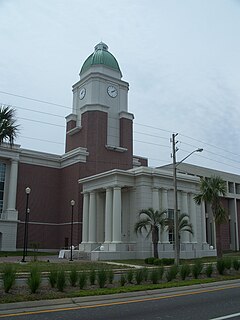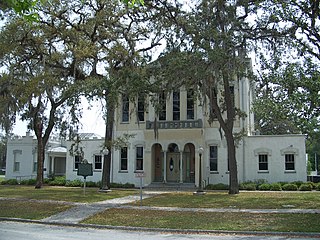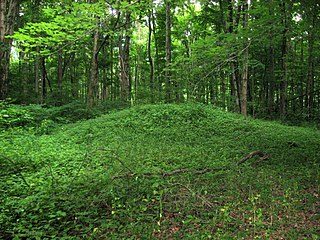
Clay County is located in the northeastern part of the U.S. state of Florida. As of 2019, the population was 219,252. Its county seat is Green Cove Springs. It is included in the Jacksonville metropolitan statistical area.

Green Cove Springs is a city in Clay County, Florida, United States. The population was 5,378 at the 2000 census. As of 2010, the population recorded by the U.S. Census Bureau was 6,908. It is the county seat of Clay County.

The Kolomoki Mounds is one of the largest and earliest Woodland period earthwork mound complexes in the Southeastern United States and is the largest in Georgia. Constructed from 350CE to 600CE, the mound complex is located in southwest Georgia, in present-day Early County near the Chattahoochee River.

The Green Cove Springs Historic District is a U.S. historic district located in Green Cove Springs, Florida. The district is bounded by Bay Street, CSX RR tracks, Center Street, Orange Avenue, St. Elmo Street and St. Johns Road. It contains 78 historic buildings and 1 structure.

Hibernia is an unincorporated community in Clay County, Florida, United States. It is located off US 17, on the western bank of the St. Johns River. It is the home of historic St. Margaret's Episcopal Church and Cemetery.

The Garden Patch is a Middle Woodland archaeological site in Horseshoe Cove, near Horseshoe Beach, Florida, off County Road 351. For a major part of its occupation, the site was a ceremonial center associated with the Swift Creek and Weeden Island cultures. On April 25, 1991, it was added to the U.S. National Register of Historic Places.

The Yent Mound (8FR5) is a Santa Rosa-Swift Creek culture archaeological site located on Alligator Harbor west of St. Teresa, Florida. It is on the east side of County Road 370, approximately 2.5 miles from the junction of U.S. Route 98. On May 24, 1973, it was added to the U.S. National Register of Historic Places.

The Bubba Midden is a historic site near Green Cove Springs, Florida. It is located on Fleming Island, northwest of Green Cove Springs. On March 2, 1990, it was added to the U.S. National Register of Historic Places.

The Cayson Mound and Village Site (8CA3) is a prehistoric archaeological site located near Blountstown, Florida. It is located three miles southeast of Blountstown, on the Apalachicola River. The site was occupied by peoples of the Fort Walton Culture. On March 15, 1976, it was added to the U.S. National Register of Historic Places.

The Safety Harbor Site is an archaeological site in Philippe Park at 2525 Philippe Parkway in Safety Harbor, Florida, United States. It is the type site for the Safety Harbor culture, and includes the largest remaining mound in the Tampa Bay area. It was designated a National Historic Landmark in 1964.

The Waddells Mill Pond Site is an archaeological site located seven miles northwest of Marianna, Florida. On December 15, 1972, it was added to the U.S. National Register of Historic Places.

The Clay County Historic Courthouse is a historic county courthouse in Green Cove Springs, Florida. The two-story brick building was built in 1889 and used until 1973. A historical marker commemorates its history. It is located at 915 Walnut Street as part of the county's Historic Triangle which includes the Clay County History Museum, Railroad Depot Display, Old County Jail and Archives Center. On June 20, 1975, it was added to the U.S. National Register of Historic Places. It was designed by Ellis and McClure. This historic location is home to Clay County Teen Court programs and is a venue for events such as mock trials, plays, swearing-in ceremonies, photo shoots and tours. The modern, fully operational Clay County Courthouse is a separate facility located at 825 North Orange Avenue in Green Cove Springs. Employees of the Clay County Clerk's Office oversee the operations of both locations' offices.

St. Mary's Episcopal Church is an historic Carpenter Gothic church located at 400 St. Johns Avenue in Green Cove Springs, Florida. On February 17, 1978, it was added to the U.S. National Register of Historic Places.

St. Margaret's Episcopal Church and Cemetery is a historic Carpenter Gothic church and cemetery located at 6874 Old Church Road in Hibernia, on Fleming Island, near Green Cove Springs, Florida, in the United States. On June 4, 1973, the church and its cemetery, which is also known as the Hibernia Cemetery, were added to the National Register of Historic Places.
The Green Cove Lions were an indoor football team intended to be based in Green Cove Springs, Florida. They played briefly in the National Indoor Football League in 2007, but folded before ever playing a home game.
Clay County Courthouse or Old Clay County Courthouse may refer to:

This is a list of the National Register of Historic Places listings in Volusia County, Florida.
The Clay County Fairgrounds, officially known as the Paul E. Reinhold Agricultural Fairgrounds, are fairgrounds located in Green Cove Springs, in Clay County, Florida, United States.

The Orators Mound is a Native American mound in the western part of the U.S. state of Ohio. Although its cultural affiliation is disputed, it is an important archaeological site.

The Spikebuck Town Mound and Village Site is a prehistoric and historic archaeological site on Town Creek near its confluence with the Hiwassee River within the boundaries of present-day Hayesville, North Carolina. The site encompasses the former area of the Cherokee village of Quanassee and associated farmsteads. The village was centered on what is known as Spikebuck Mound, an earthwork platform mound, likely built about 1,000 CE by ancestral indigenous peoples during the South Appalachian Mississippian culture period.














